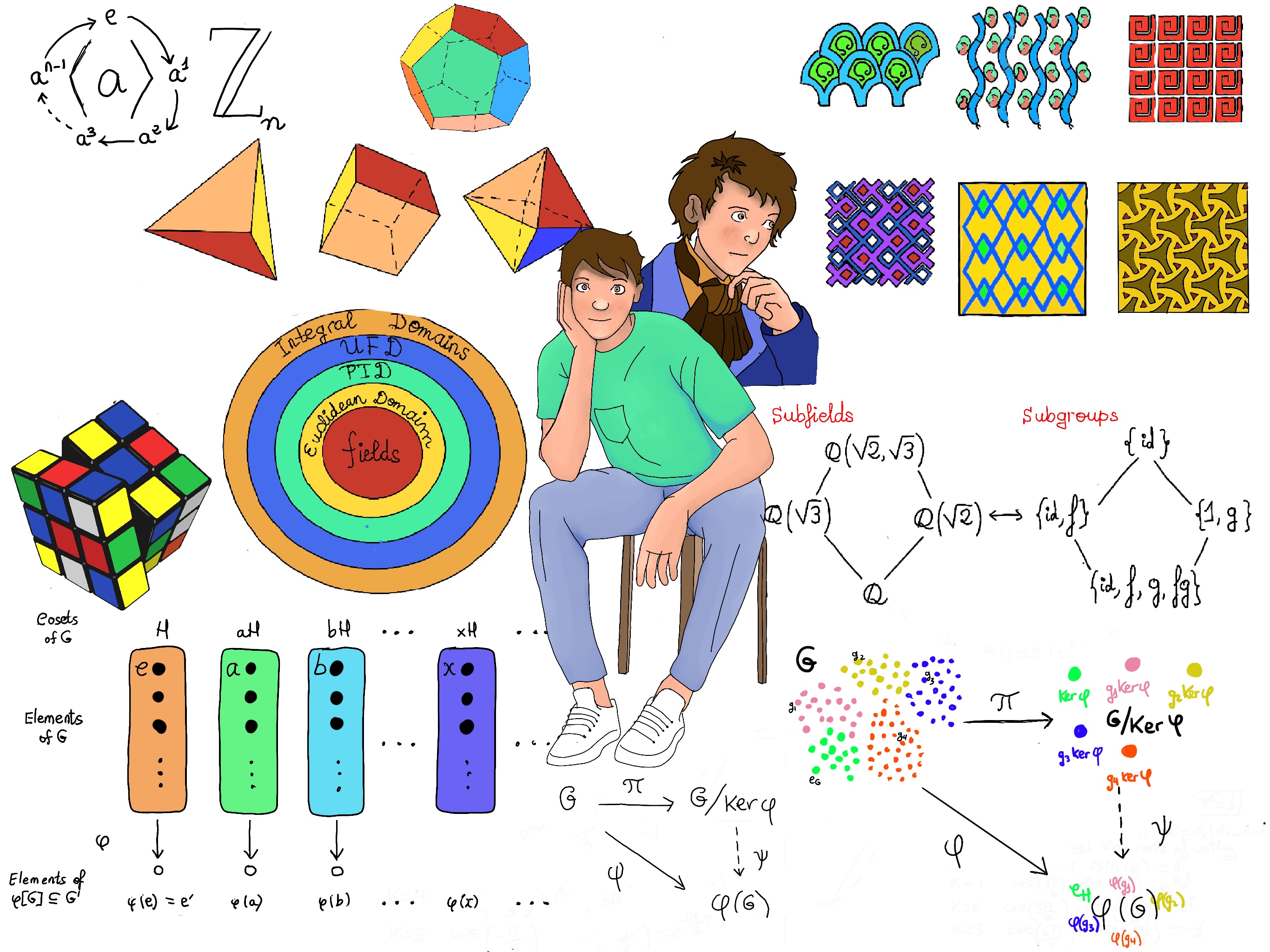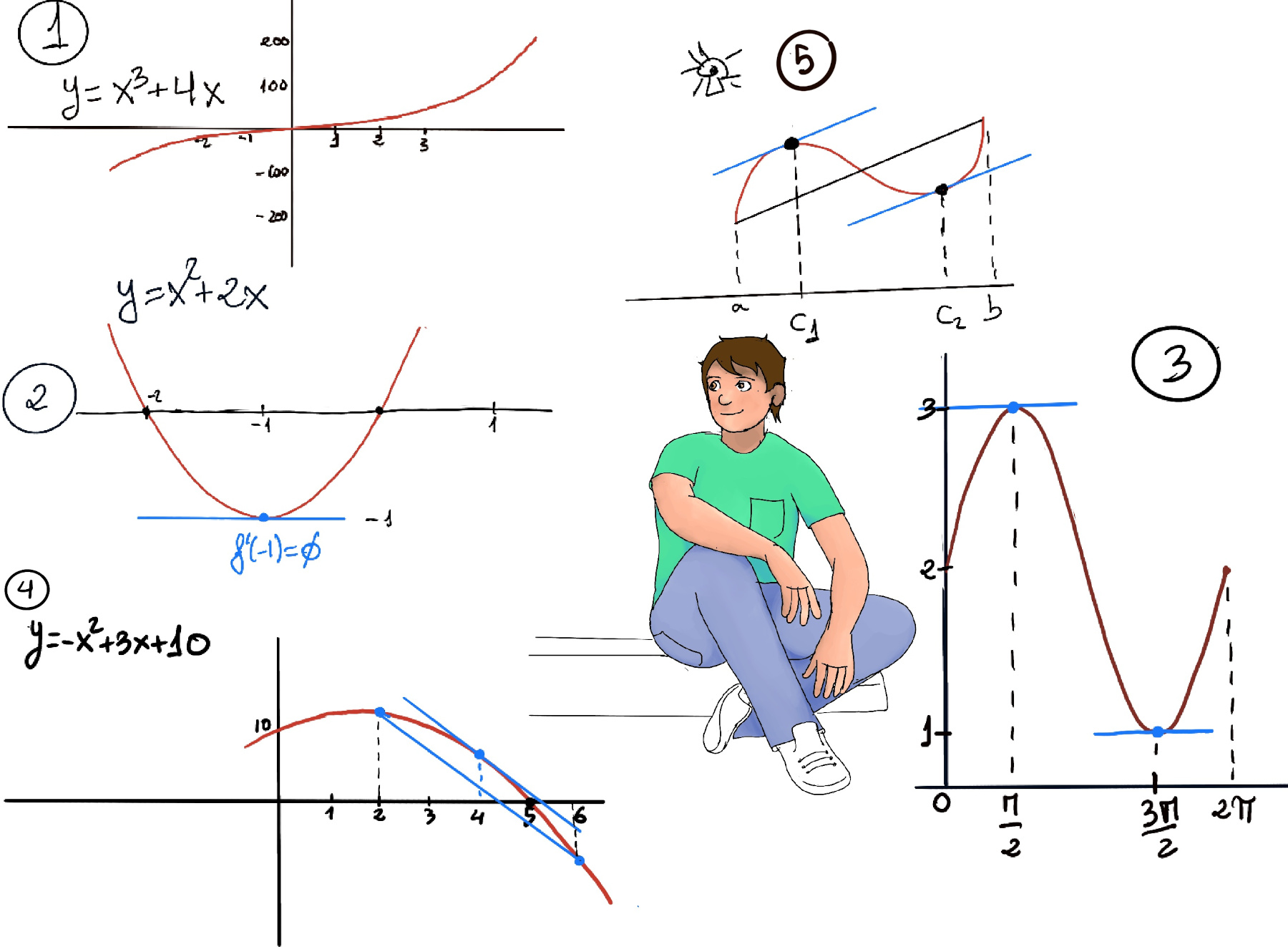
|
 |
 |
|
 |
Success is not final, failure is not fatal: It is the courage to continue that counts, Winston Churchill.

Extreme Value Theorem. If f is a continuous function on an interval [a,b], then f has both a maximum and minimum values on [a,b]. It states that if a function is continuous on a closed interval, then the function must have a maximum and a minimum on the interval (Figure 1.f.) 
Fermat’s Theorem. If a function ƒ(x) is defined on the interval (a, b), it has a local extremum (relative extrema) on the interval at x = c, and ƒ′(c) exists, then x = c is a critical point of f(x) and f'(c) = 0 (Figure 1.a.)
Rolle’s Theorem. It states that any real-valued differentiable function that has equal values at two distinct points must have at least one stationary point somewhere between them, that is, a point where the first derivative is zero. If a real-valued function f is continuous on a proper closed interval [a, b], differentiable on the open interval (a, b), and f (a) = f (b), then there exists at least one c in the open interval (a, b) such that f'(c) = 0 (Figure 1.c, 1.d). 
Proof. There are two cases.
M ≠ m. Otherwise, if M = m, then f is constant ∀x in [a, b] ⇒ f’(x) = 0 ∀x in [a, b], and we can take c to be any number in the interval (a, b).
If M ≠ m. If f(a)=M, then f(b) = f(a) = M ⇒ m have to occur in the open interval (a, b). Therefore, there is at least one maximum or minimum in the open interval (a, b).
Without lose of generosity, let’s assume that f has a maximum in the open interval (a, b), that is, f has a maximum at some c in (a, b) ⇒ [By Fermat’s Theorem, f has a maximum at c ∈ (a, b) and f is differentiable on the open interval (a, b), so f’(c) exists] f’(c) = 0 ∎
The mean value theorem states that if f is a continuous function on the closed interval [a,b] and differentiable on the open interval (a, b), then there exists a number c ∈ (a,b) such that the tangent at c is parallel to the secant line through the endpoints, that is, $f’(c) = \frac{f(b)-f(a)}{b-a}$. Figure 1.e. and 5 (at least a number c ∈ (a,b), it may have two or more c1 and c2).

In other words, there exist a point c within that open interval where the instantaneous rate of change equals the average rate of change over the interval.
Geometrically, it states that the slope of the secant line through the end points is the same as the slope of the tangent line at x = c. Physically, there is a point at which the average velocity is equal to instantaneous velocity. 
Proof.
We will use Rolle’s Theorem. If a real-valued function f is continuous on a proper closed interval [a, b], differentiable on the open interval (a, b), and f (a) = f (b), then there exists at least one c in the open interval (a, b) such that f'(c) = 0.
Let $g(x) = f(x) - \frac{f(b)-f(a)}{b-a}x$
$g(a) = f(a) - \frac{f(b)-f(a)}{b-a}a = f(a)(1+\frac{a}{b-a})- a\frac{f(b)}{b-a} = f(a)\frac{b}{b-a}- f(b)\frac{a}{b-a}$
$g(b) = f(b) - \frac{f(b)-f(a)}{b-a}b = f(b)(1-\frac{b}{b-a})+ b\frac{f(a)}{b-a} = f(b)\frac{-a}{b-a}+ f(a)\frac{b}{b-a} = g(a)$
Therefore, ∃c ε (a, b): g’(c) = 0
$g’(c) = 0 = f’(c) - \frac{f(b)-f(a)}{b-a} ⇒∃c ε (a, b): f’(c) = \frac{f(b)-f(a)}{b-a}$∎
Figure 2. By Roller’s theorem, ∃c ∈ (-2, 0) such that f’(c) = 0.

f’(x) = 2x + 2 ⇒ 2c +2 = 0 ⇒ 2(c + 1) = 0 ⇒ c = -1. Therefore, x = -1 is the point where the slope of the secant line through the end points 0 and 2 is the same as the slope of the tangent line at x = -1 (f’(-1) = 0).
Figure 3. By Roller’s theorem, ∃c ∈ (0, 2π), there may be more than one, such that f’(c) = 0.
f’(x) = cos(x) ⇒ ∃c ∈ (0, 2π): cos(c) = 0 ⇒ $c = \frac{π}{2}, c = \frac{3π}{2}$.
Let f(x) = $\frac{1}{x^2}$ over [-1, 1], f(-1) = f(1) = 1, but since f is undefined at x = 0, it does not satisfy all conditions of Rolle’s theorem.
Let f(x) = x3 +4x over [-1, 1], f(-1) = -5, f(1) = 5. Since f is a polynomial, it is both continuous and differentiable everywhere.
Figure 1. By the MVT, ∃c ∈ (-1, 1): f’(c) = $\frac{5-(-5)}{1-(-1)} = \frac{10}{2} = 5.$

f’(x) = 3x2 +4 ⇒ $5 = 3·c^2 +4 ⇒ c = ±\sqrt[3]{\frac{1}{3}} = ±\frac{1}{\sqrt{3}} = ±\frac{\sqrt{3}}{3}≈ ± 0.58$. The vertical scale is so large that the “interesting” part of the graph looks like it is almost all zero.
If f is not differentiable, even at a single point, the result may not holdbecause it does not satisfy all conditions of Rolle’s theorem.
Figure 4. The average rate of change = $\frac{f(6)-f(2)}{6-2} = \frac{(-36+18+10)-(-4+6+10)}{4} = \frac{-20}{4} = 5.$

Since f is a polynomial, it is both continuous and differentiable everywhere. By the Mean Value Theorem, ∃c ∈ (2, 6): f’(c) = -2c +3 = -5, c = 4 is the point at which the instantaneous rate of change equals the average rate of change.
| t (minutes) | 0 | 5 | 15 | 20 | 30 |
|---|---|---|---|---|---|
| f(t) (meters) | 0 | 40 | 70 | 65 | 80 |
The average ballon velocity (20, 30) = $\frac{f(30)-f(20)}{30-20} = \frac{80-65}{10} = 1.5$ meters/minutes ⇒ Since f is twice-differentiable, according to the Mean Value Theorem, there must be at least a value c ∈ (20, 30) where f’(c), that is, the ballon’s (instant) velocity is 1.5.
Let’s suppose f is continuous on the interval [a, b], and diferenciable on (a, b).
Proof: ∀ x1, x2 ∈ (a, b), x1 < x2, then $x_2-x_1>0$ and the Mean Value Theorem guarantees that we can find a c ∈ (x1, x2): $\frac{f(x_2)-f(x_1)}{x_2-x_1}=f’(c)$ ⇒ $f(x_2)=f(x_1)+f’(c)(x_2-x_1)$
Since x3 -3x2 +3x +5 is a polynomial ⇒ f is continuous and differentiable on ℝ. f’(x) = 3x2 -6x +3 = 3(x -1)2 ≥ 0 ∀x ∈ℝ ⇒ f is increasing on ℝ.
Since 2x3 -15x2 + 36x +5 is a polynomial ⇒ f is continuous and differentiable on ℝ. f’(x) = 6x2 -30x +36 = 6(x -2)(x -3).
Let be f(x) = ex -x -1, f is continuous and differentiable on (0, ∞), f(0) = 0, f’(x) = ex-1 > 0 ∀x >0 (Recall, ex is monotonically increasing, e0 = 1) ⇒ f is increasing ∀x >0 ⇒ f(x) > 0 ∀x >0 ⇒ ex -x -1 > 0 ⇒ ex > x + 1 ∀x >0
Similarly, let be g(x) = ex -x -1 -$\frac{x^{2}}{2}$, g(0) = 0, g’(x) = ex -1 -x > 0 ∀x >0 (previous example) ⇒ g is increasing ⇒ g(x) > 0 ∀x >0 ⇒ ex > x + 1 + $\frac{x^{2}}{2}, $∀x >0
Futhermore, ex > x + 1 + $\frac{x^{2}}{2} + \frac{x^{3}}{3.2} + …$ (it is left for the reader as an exercise), but in the infinite they are both equal.